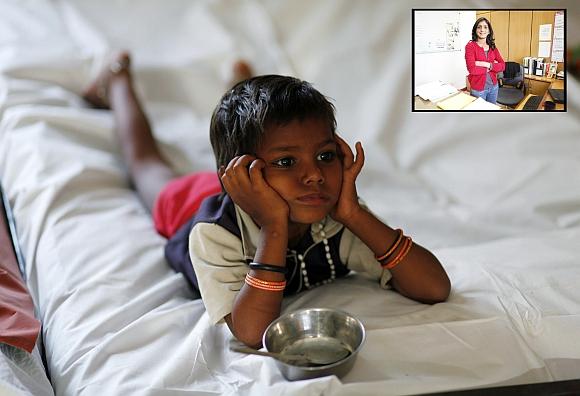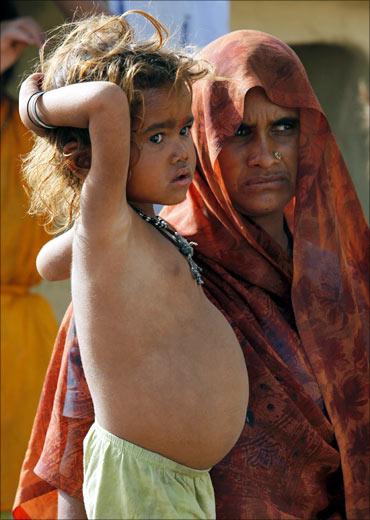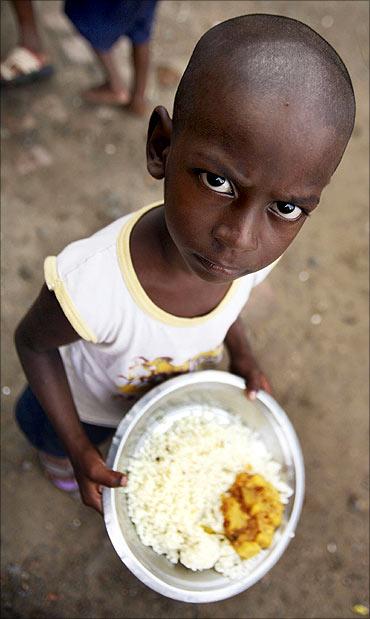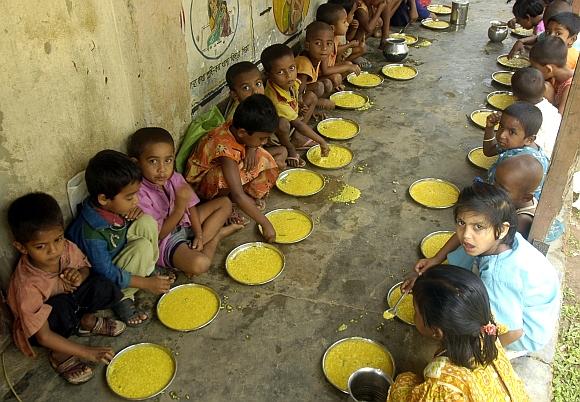Photographs: Reinhard Krause/Reuters Shobha Warrier
Recently, a study on India's State Hunger Index comparing hunger across all India states was released by Purnima Menon, Anil Deolalikar and Anjor Bhaskar.
Dr Purnima Menon is a research fellow at the International Food Policy Research Institute's Poverty, Health and Nutrition Division, and is based at IFPRI's Asia office in New Delhi.
She conducts applied nutrition research in the South Asia region, with a focus on programs and policies to improve maternal and child nutrition.
Now, she leads a team that conducts impact and process evaluations of Alive and Thrive, a Bill & Melinda Gates Foundation-supported initiative to improve infant and young child feeding and child nutrition in Bangladesh, Vietnam and Ethiopia.
In this email interview with Rediff.com's Shobha Warrier, Dr Menon talks about the study and the necessity to have proper data collection at regular intervals.
According to the Global Hunger Index 2008, India stands 66th out of 88 countries. Five years have passed. Do you think India's performance at reducing hunger has improved?
It is really hard to know what India's current situation is or India's performance has been because since 2005-06, there has been no national level data that helps us understand this.
India has not invested in one of the most basic things, i.e., updating the data on the nutrition situation across the country. The hungama data, collected in 100 districts, provides some insight into possible improvements over time, but nothing is available at the national level.
...
India's scores on the GHI are really driven by poor child nutrition
Image: Ranbir, twenty-six-months, who weighs 5 kg and suffers from severe malnutrition, waits for food at the Nutritional Rehabilitation Centre of Shivpuri district in Madhya PradeshPhotographs: Reinhard Krause/Reuters
From your research findings, could you understand why India stands so low in the GHI? Is it lack of political will or lack of proper policies or poor implementation?
One of the main reasons that India's score on the GHI is low is the situation with child undernutrition (which is one of the components of the GHI.
Until and unless the child undernutrition numbers improve, India's score on the GHI will be low.
The reasons for poor child nutrition in India are really manifold -- child undernutrition is a marker of many things wrong with society -- social equity, poverty, women's education and empowerment, women's nutrition, poor sanitation, etc.
These are all ultimately reflected in poor child nutrition.
There are certainly issues of political will and implementation -- and the lack of data is, to me, a good indicator of the lack of true political attention to nutrition as a problem.
Your study says that India ranks below several countries in sub-Saharan Africa, such as Cameroon, Kenya, Nigeria, and Sudan in GHI, even though per capita income in these Sub-Saharan African countries is much lower than in India. What could be the reason why India performs so poorly in fighting hunger?
India's scores on the GHI are really driven by poor child nutrition, and on this indicator, we fare worse that most countries in the world. When we look at the India state hunger index, Punjab is at the top followed by Kerala.
...
It is possible that things have improved very much in Gujarat
Photographs: Reuters
Andhra Pradesh is considered as a poor state comes third. Is it because of surplus food production that Punjab and Andhra Pradesh are at the top?
We have not done a state by state analysis of the overall scores on the ISHI.
Is it not a shame that in 2013, we are analysing a data collected in 2008?
It is a terrible shame, indeed. Even the ISHI 2008 is based on data from 2005-06, so yes, the real shame is that even in 2013, the only nutrition data we have available for the whole country is from 2005-2006.
Gujarat is placed at number 13 in the ISHI which according to the chief minister is not right in the present context. Do you feel things have changed for the better there as it is said to be one of the most industrialised states?
It is possible that things have improved very much in states such as Gujarat, but without the empirical data, it is impossible to say. If the economic growth in Gujarat was concentrated and if social sector investments were too low to improve equity, then it is likely that things did not improve as much.
On the other hand, if Gujarat's growth has been equitable, and combined with solid social sector spending and governance improvements, it's indeed possible that things are better.
But, without the state-level data, it is really difficult to conclude anything. States such as Gujarat and Maharashtra, would do well to establish survey mechanisms to give them good data on a more frequent basis.
...
Not clear why India is behind on data collection
Image: A student holds his free mid-day meal, distributed by a government-run primary school, in RajporePhotographs: Jayanta Shaw/Reuters
Agricultural growth in a state such as Gujarat is in double digits now. Do you feel agricultural growth and industrialisation will have a positive impact on alleviating hunger?
The pathways between agricultural growth and hunger outcomes is fairly complex and nuanced. The IFPRI's work on 'tackling the agriculture-nutrition disconnect in India was aimed at elucidating some of these pathways.
Do you feel it is necessary for the Indian government to collect nutrition data every year so that policies can be made accordingly?
Data collection definitely needs to be more frequent than it is right now! Good survey data, such as the NFHS, every two to three years would be more than welcome and will allow a solid tracking of the trends.
On the other hand, other types of program data on a more frequent basis are needed to track use of services, and so on.
Why is it that we are several years behind in data collection? Do you think other countries far ahead of us in this and hence they are better off in fighting hunger?
It is not very clear to me as to why India, with all the expertise we have, is so behind on data collection.
Certainly, not having the data really does hold back the fight against hunger, and it is true that countries that have done better than us have also had good data collection mechanisms.
But, the data mechanisms are simply a marker of a greater commitment to the problem -- and of monitoring progress on it.
...
Countries such as Bangladesh also has a combination of surveillance on a frequent basis
Image: Students have a free meal distributed by a government-run school in Nalchar village, 70 km south of Agartala, TripuraPhotographs: Jayanta Dey/Reuters
How do other countries, developed, developing and under developed countries fare in collecting data and fighting hunger?
There is a lot of variability on how other countries tackle their data situation. Countries such as Vietnam have annual nutrition data collection for program planning and surveillance as well as deeper but less frequent data collection.
Countries such as Bangladesh also have a combination of surveillance on a frequent basis and deep surveys more frequently (every 3 years). Of the high burden countries, India's performance and commitment to obtaining data on nutrition is exceptionally poor.
Once when I interviewed Prof M S Swaminathan, he said, we produce enough food to feed all the people in the country but they do not have the purchasing power to buy food. Do you take this into consideration when you look at the hungry in India?
The overall nutrition and food security situation of a population using indicators such as the Global Hunger Index or the ISHI reflect the availability and access elements as well as the utilisation of foods and nutrients.






article